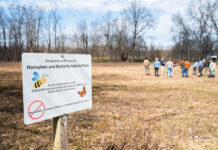WEST LAFAYETTE, Ind. — The nation’s farmers say they are shifting a large amount of acreage back to soybeans in 2008, according to the U.S. Department of Agriculture’s Prospective Plantings report after a year of heavy corn acreage, said a Purdue University expert.
Producers intend to plant 74.8 million acres to soybeans, an increase of 11.1 million acres or 18 percent more than last year. In contrast, corn acreage is expected to drop by 7.6 million acres to 86 million, an 8 percent reduction.
Hold on.
“But hold on a minute,” said Chris Hurt, Purdue Extension agricultural economist, during the Ag Outlook meeting.
“Since the USDA survey was completed in early March, the financial incentives have shifted back toward corn.”
Indiana and Ohio farmers are following the soybean parade, Hurt added. According to the report, Indiana soybean producers say they will raise soybean acres by 800,000 with a similar drop in corn acres.
Ohio producers are increasing soybean acres by 350,000 and decreasing corn by 500,000. Both states also have an increase in wheat acres with 130,000 more in Indiana and 200,000 more wheat acres in Ohio.
The report shows producers followed market incentives.
“Throughout the fall and winter, wheat and soybean prices for 2008 crops provided higher expected returns than corn,” Hurt said.
Reasons.
“For much of the winter, the premium for soybeans over corn was about $20 to $30 per acre.
“In addition, many producers pointed out that the direct costs per acre for soybeans was about half that of corn, which meant less borrowing from lenders.”
Since more corn was planted in 2007, shifting back to more soybeans in this year will bring many farmers back closer to normal crop rotations, Hurt pointed out.
“But these financial incentives shifted strongly back to corn during the month of March, after the survey was completed,” he said.
“This leaves the market with little information about what farmers actually will plant.”
The report shows that farmers will plant far too little corn to meet demands and too many soybeans, Hurt said. This means market prices must now provide strong incentives to unwind some of the “shift to soybean attitude.”
Markets will do this with higher corn prices relative to soybeans.
Corn returns.
From the report numbers, Hurt estimates a minimum of 3 million acres need to be shifted from soybeans to corn. Hurt said this is very likely as the returns to corn are now about $135 per acre more than soybeans on average quality land as of March 31; and for high-quality land that incentive is over $200 per acre.
“Even though farmers are ready to head to fields as soon as soils dry, they need to reconsider their acreage decisions,” he said.
“Corn is making a desperate, last-ditch effort to buy more acres and some producers throughout the country need to take another look at corn.
“The 2008 acreage battle is not over, and unfortunately, it will be June 30 before USDA releases the final planting numbers and the results of the battle will finally be known.”
Hurt said corn prices are expected to provide good pricing opportunities in coming weeks and producers should consider adding to their old and new crop sales positions; however, soybean prices will be on the defensive under the prospects of too many soybean acres.
Weather.
Wet and cool weather conditions in the early spring are also expected to raise concerns for delayed corn planting and the potential to shift even more acres toward soybeans.
Overall, this means many producers will be hesitant to price soybeans until acreage and the weather picture clears, Hurt said.











